Fear Versus Facts: effective communication for coexistence with large carnivores
Photo from Rodopi National Park, Greece
How can Protected Areas effectively communicate towards ensuring constructive dialogues and building acceptance of large carnivores amongst local communities? To reflect on this question and understand the challenges ahead, EUROPARC with the collaboration of the EU Platform for Coexistence between People and Large Carnivores, organised a workshop at the EUROPARC Conference 2018, which took place in the Cairngorms National Park (Scotland, UK) last month. Experts in large carnivores and protected area professionals gathered to find out solutions and share experience. This is what they’ve found out:
1) From conflict to collaborative work
One of the main challenges for conflict management is to overcome communication and language barriers between the different categories of stakeholders. Antagonism is frequently a result of the fact that each group simply wants to push forward its own agenda, without listening to others. There is, instead, a clear need to provide guidelines and expertise on how establishing a constructive dialogue and to improve the communication skills of professionals.
Problems related to coexistence with large carnivores are inevitably complex and for this requires complex answers: simplified messages are counterproductive. For this reason,
the first step is to ensure that parties acknowledge the existence of the problem, which has to be clearly identified and defined.
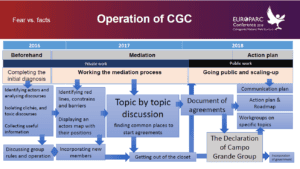
Click on the image to download the presentation of the Campo Grande Group at Workshop “Fear versus Facts” (EUROPARC Conference 2018, Scotland)
Case Study 1: Campo Grande Group (Spain)
Pedro Herrera, from Foundation Entretantos (Spain), presented the existing conflict with the Iberian wolf and explained how they have helped set up a working group which integrates farmers, ecologists, hunters, researchers, and wolf specialists, and through several participatory processes and meetings, they launched the Declaration of the Campo Grande Group.
2) Effective Mediation in 8 steps
Gathering stakeholders and give them the chance to speak and share their perspective is essential, but the role of the moderator is essential to keep the group focused on the existing problem. Often, large carnivores are labeled as the core problem, while they soon appear to be sort of “nuance” to raise or discuss other issues or secondary elements of bigger – and less tangible – problems (as for instance local or regional policy; access to funding; rural development…).
When conflicts originate, some tips to better manage have been discussed and identified by the workshop participants. Among those:
- Analyse and plan
It is crucial to develop in advance good communication processes and plans. What will be the key outputs of my working sessions? Who are the most relevant stakeholders? Which tools can we use to engage them? Those will contribute to make messages more consistent and effective. Communication is a complex tool and needs to have a clear purpose in order to contribute to solve the issue.
- Adapt to your audience
It is important to speak the “language” of the stakeholders we are dealing with: farmers, hunters.
- A neutral agent in the room
Trying to solve a complex issue requires negotiation ability and acceptance of compromises. For this, it is highly recommended to involve third parties, professional mediators and facilitators.
- Promote knowledge share
Provide learning exchanges and site visits to build mutual understanding and trust. You can also explore solutions from different regions and to discuss the concrete side of the problem by hearing and understanding how others are doing it.
- Open up to different perspectives
It is important to consider the ecosystems in their complexity and from different perspectives. All species are relevant, both the wolf and the sheep. Develop active listening with your stakeholders, understand their needs and stimulate a healthy share of ideas and perspectives.
- Don’t forget the people dimension
Put emphasis on people and show activities that can be undertaken to solve their problem – take emotions into account, without forgetting facts/data.
- Create a friendly environment
Stakeholders need to know each other: create opportunities to overcome the mental barriers. They need to find the pleasure in staying together: music, food, fire and drinks are very important ingredients.
- Identify key persons
It is very useful to identify persons within the different stakeholder’s groups who can help to mediate and pass positive messages among their colleagues. On the other hand, it is also crucial to identify those who generate a negative feeling among the community (for example, writing articles, disruptive news, inflaming people, creating sort of fake associations / representing groups of stakeholders and then express positions on behalf of the whole community…) and work directly with them.
Case study 2: Sense and Sensibility – Rethink the Rational Approach in Large Carnivores Communication
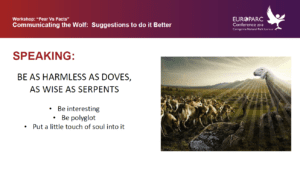
Click on the image to download the presentation of the project Life WolfAlps, at the workshop “Fear versus Facts” (EUROPARC Conference 2018, Scotland)
Irene Borgna, Communications Manager of the Life WolfAlps Project (coordinated by the Alpi Marittime Regional Park, Italy), shared the main challenges in communicating the natural return of the wolf in the Alps. What were the main obstacles? What are the lessons learned to overcome them?
3) How to empower Protected Area Managers
In terms of support required by Protected Areas managers, the following aspects were identified:
- Practical case studies, not just from protected areas, but mainly from the farmers perspective, to understand where things are working better. A common database to access resources would surely be useful. Meanwhile, the EU Platform of coexistence between people and Large Carnivores has already available a wide collection of case studies.
- More opportunities for learning exchange and study tours (mixt groups of stakeholders)
- Coordinated actions and information to make public and stakeholders aware that protected areas are well conscious of the problem and are working to solve it.
- More attention to be devoted to people and not only on the species in the development and management of projects, in the production of guidance.
- Training and support in mediation processes and facilitation.
- Have access to a unified database of information, a sort of communication toolkit that would collect relevant information from various projects.
Case study 3: The EuroLargeCarnivores LIFE project
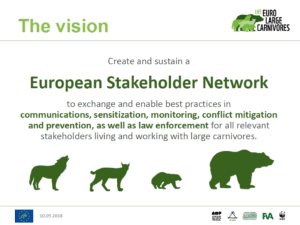
Click on the image to download the presentation about the EuroLargeCarnivores Life project, at “Fear versus Facts” workshop (EUROPARC Conference 2018, Scotland)
László Patkó, Large Carnivore Programme Manager at WWF Hungary, introduced the EuroLargeCarnivores project that aims to provide a discussion space for people to share and learn about experiences of managing the presence of large carnivores. This includes various approaches across Europe associated with social, economic and ecological challenges. Topics include monitoring, conflict mitigation, damage prevention, security concerns, long-term effects on agriculture and hunting, management practices, as well as assisted economic opportunities.

Parks, Communities, Territory and Competences – Federparchi Congress 2018
The IX Congress of Federparchi – EUROPARC Italy
Climate change and the need for sustainable development are intertwined issues that can no longer be avoided. Skills are needed to meet the challenges of the future. This will be one of the main themes of the two days of Federparchi to be held in Rome on 24 and 25 October.
The Congress of the Italian Federation of Protected Areas and EUROPARC Italian Section has as its theme: “Parks, communities, territory, and competences: the challenges of the future for protected areas”. The crossroads between the role of communities, the protection of the territory and biodiversity, the enhancement of skills and the need to have professional profiles able to deal with the new reality, are the lines of understanding for Italian protected areas to be a model of sustainable development, as well as areas of protection and conservation of nature and habitats.
In Italy there are 24 National Parks, 134 Regional Parks, 147 State Nature Reserves, 27 Marine Protected Areas (plus three in the process of being established), and over 360 Regional Reserves.
The Congress will gather representatives from the national and regional parks and the Italian protected areas, but will als count with the participation of the local authorities, environmental and civil organisations, of the scientific research. The meeting will take place in Rome, at the Grand Hotel de la Minerve – Piazza della Minerva 69.
For more information please visit Federparchi Website
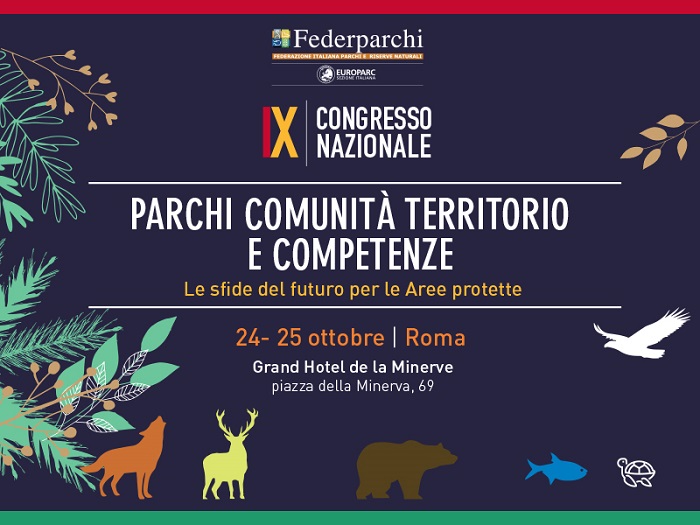
Dutch National Parks on the way up again
Sunrise in the Oostvaardersplass © New Land National Park, extracted from www.nationaalparknieuwland.nl
article issue by Hans Schiphorst, coordinator of the Samenwerkingsverband Nationale Parken
Dutch National Parks on the way up again
The Dutch National Parks faced a difficult period over the last couple of years. It was the result of an unclear situation regarding the position of national parks in Dutch nature policies: a lot of these policies were decentralized from Central Government to Provincial Government, but the position of National Parks was unclear.
It resulted in a confusing situation regarding governance and finance of the National Parks. Due to an amendment in Parliament, calling upon the minister to safeguard and rejuvenate National Park policies, we are on the way up again. Not all is sorted yet, but
there is a positive movement again, resulting in a new National Park standard and in designating the Netherlands 21th and newest National Park, called Nieuw Land National Park.
The Nieuw Land National Park (New Land National Park)
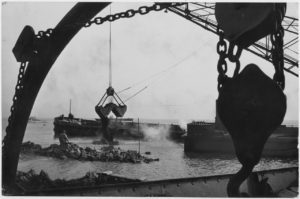
Read more about the Zuiderzeeproject
https://www.nationaalparknieuwland.nl/nl/geschiedenis-flevoland
© Nieuw Land National Park
With a total of almost 29.000 hectares, it is one of the biggest National Parks in the Netherlands. The Nieuw Land National park is situated in the middle of the country, in and around the big central lake in the Netherlands “IJsselmeer and Markeermeer”, the former “Zuiderzee”. In the nineteen forties of the last century, a big floodwall was build in the north of the country, changing the salt water Zuiderzee into the freshwater IJsselmeer.
Part of IJsselmeer and Markermeer was subsequently converted into big polders, some 4 meters below the water table. A part of these polders was never converted into arable land or used for building houses as almost overnight an area with great ecological qualities emerged: the Oostvaardersplassen, internationally recognized for its waterfowl and huge numbers of big grazers like Heck cattle, Red Deer and Konik horses. This part of the National Park is about 6000 hectares.
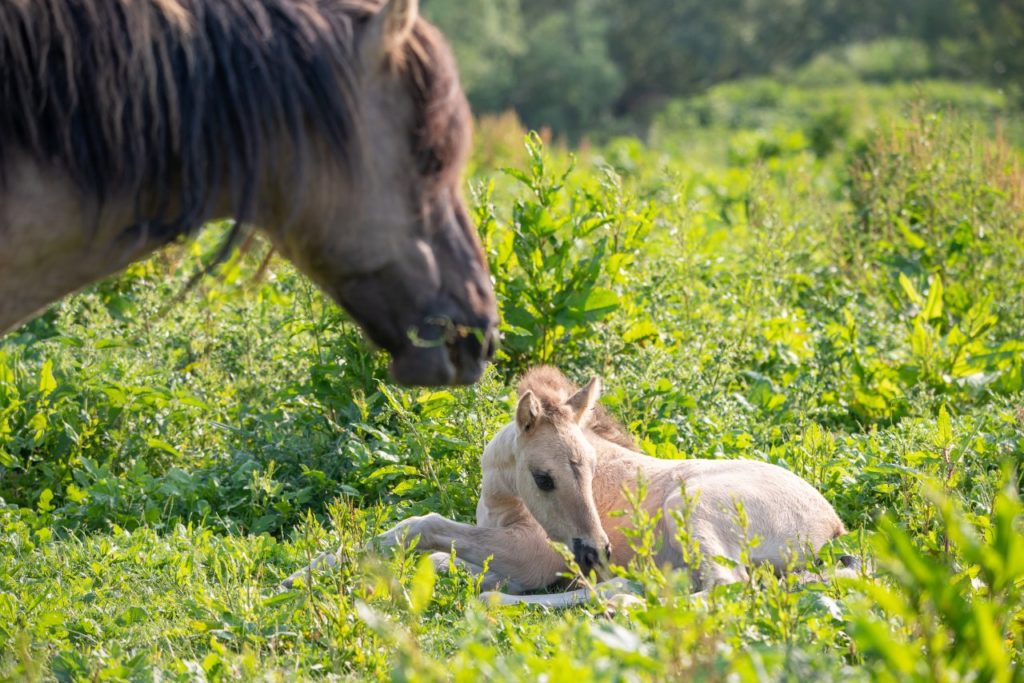
Konik horses in the Oostvaardersplassen © New Land National Park, extracted from www.nationaalparknieuwland.nl
Man & Nature
A second part of the National Park is the “Marker Wadden”. It is a newly created area of sandplates, roughly 10.000 hectares. These sandplates are created in order to stimulate the ecological qualities in this part of the Markermeer.
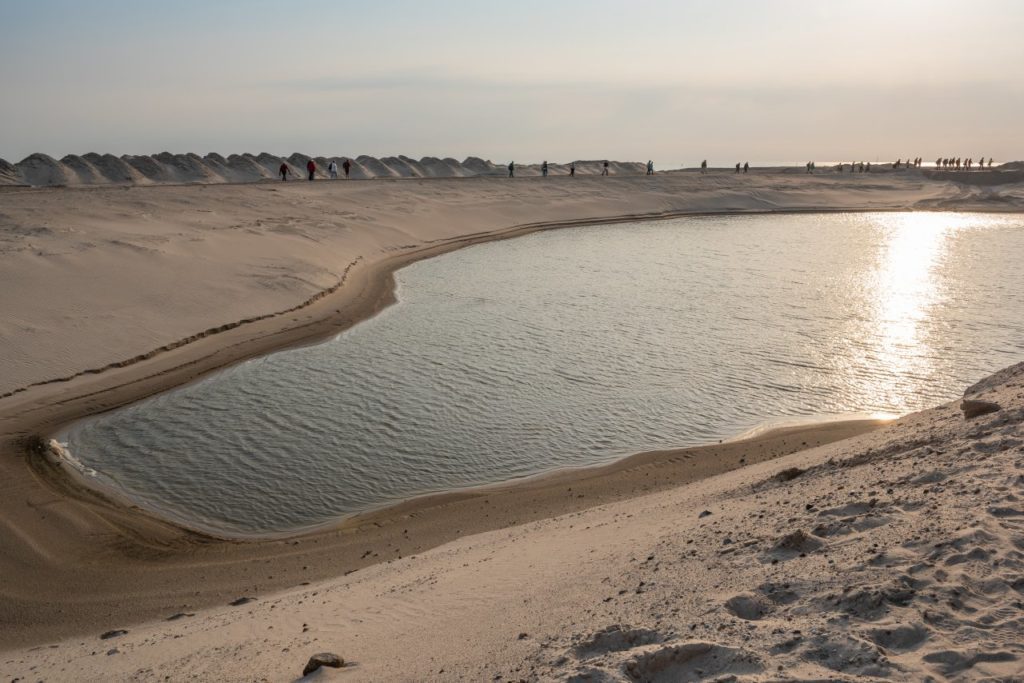
Marker Wadden, man-made Sandplates© New Land National Park, extracted from www.nationaalparknieuwland.nl
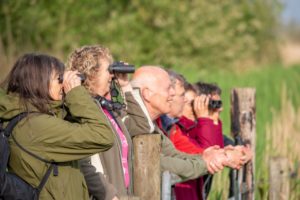
Birdwatching in the Lepelaarplassen, © New Land National Park, extracted from www.nationaalparknieuwland.nl
The rest of the National Park consists of a part of the Markermeer and the Lepelaarsplassen, the latter area mainly consists of reedbeds and wet grasslands known for its spoonbills (Lepelaar in Dutch) and other waterfowl and marsh birds. A haven for hundreds of bird species.
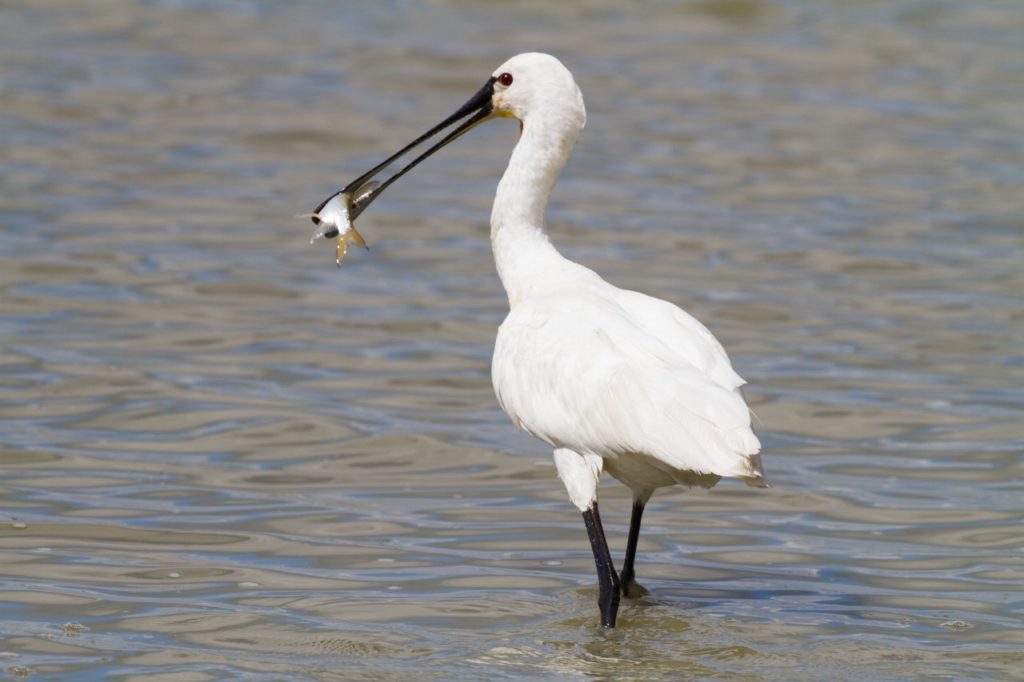
Lepelaar, New Land National Park © Herbert Jan Koopmanextracted from www.nationaalparknieuwland.nl
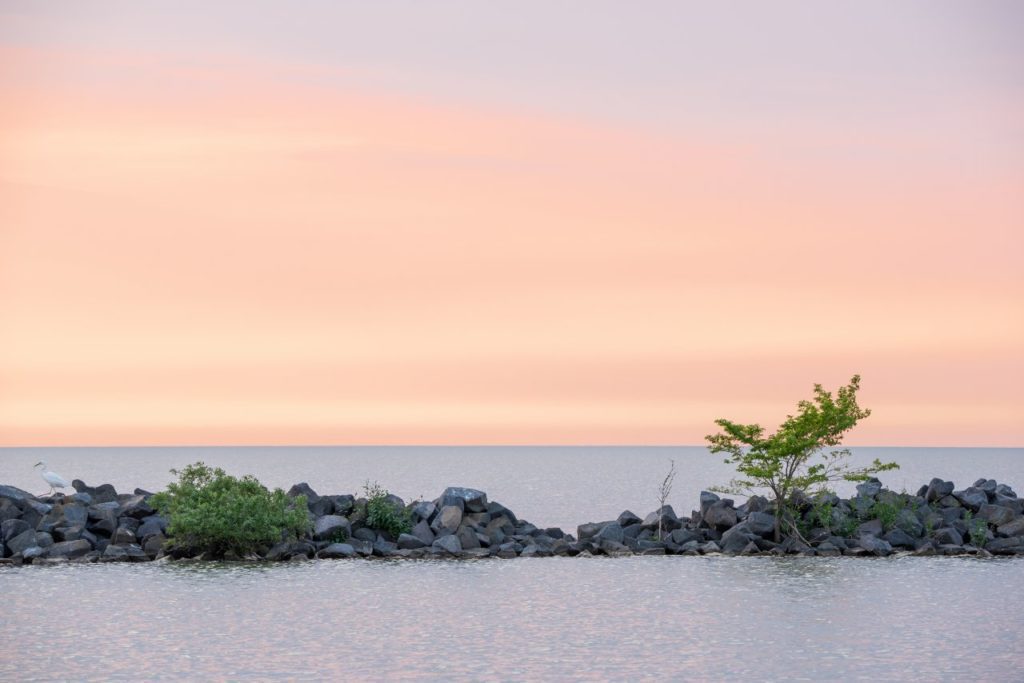
Markermeer © New Land National Park, extracted from www.nationaalparknieuwland.nl
The Nieuw Land National Park is not only the Netherlands newest and latest National Park, but also an example of man-made nature where you will also find the remains of former occupation by the Romans and interesting naval-history and – archeology.
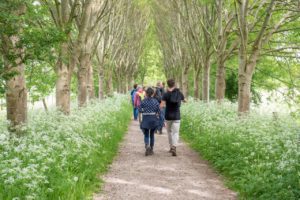
Visitors in the Oostvaardersplassen © New Land National Park, extracted from www.nationaalparknieuwland.nl
Check out what you can do & see in the Park. All information available at https://www.nationaalparknieuwland.nl
A global moratorium on depleting and destroying ecosystems
Article issued by Ignace Schops, EUROPARC President
“A half of a degree less, makes a world of difference”, said UN Secretary-General António Guterres. The IPCC special report “Global Warming of 1.5°C” was very clear. Unless we become climate neutral by 2050, we will face severe problems. Limiting global warming to 1.5°C will require “unprecedented” transitions.
The UN Secretary-General stressed the need to plant billions of trees; drastically reduce fossil fuel use and phase out coal by 2050; ramp up the installation of wind and solar power; invest in climate-friendly sustainable agriculture and consider new technologies such as CCS. In this regard, he urged countries to raise their ambition, strengthen their nationally determined contributions (NDCs) and urgently accelerate implementation of the Paris Agreement.
As far as we know growing new forests, investing in new nature and marine reserves and safeguarding natural systems are most reliable and cheapest way to tackle global warming.
Unfortunately, our life balancing ecosystems are threatened day after day. Habitats and species disappear as snow in the sun… and so the carbon buffer capacity of ecosystems. The autonomous evolution is negative. I repeat: negative!
Since the rise of human civilization 83% of the wild mammals, 80% of the marine mammals, 50% of the plants and 15% of the fish have been lost. We are playing with (our) life on earth! In his book “half-Earth”, the great Edward O. Wilson rightly states that
if we want to sustain on a healthy biodiverse planet, we need to reserve at least half of the earth for the protection of nature.
We are losing our comfort zone! Isn’t it time to take a new big simple idea forward that jointly helps to tackle the problems of climate change and biodiversity loss? How? Well, maybe it is time for an extra incentive and to invest in what we have and cannot afford to lose.
In other words: a global moratorium on depleting and destroying ecosystems.
A stand-still-principle as the starting situation. Combined with a system to reimburse regions who are willing to create new buffer zones, (re)plant forests or enlarge existing ecosystems. The mechanism to activate this idea could be the PES, Payments for Ecosystem Services. The basic idea behind PES is to pay those who provide ecosystem services should be paid for doing so.
One of the collective goals of the Paris Agreement is to mobilize US$ 100 billion a year in climate finance for de developing countries by 2020. Let’s secure this budget for this purpose. The developing countries need all the support we can get. But is it such a big problem to top this budget with an extra US$ 50 billion? The advantage is it could be a big win-win-situation: for the healthiness and the future of our planet. To tackle climate change and to safeguard our natural heritage!
The more we invest in the livelihoods of our living engine, the longer our precious planet will give us and all its creatures to the pleasure of living on it!
Think globally, act locally and change personally!
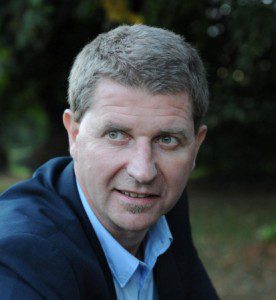
Ignace Schops © Don MacMonagle
Ignace Schops
President EUROPARC Federation